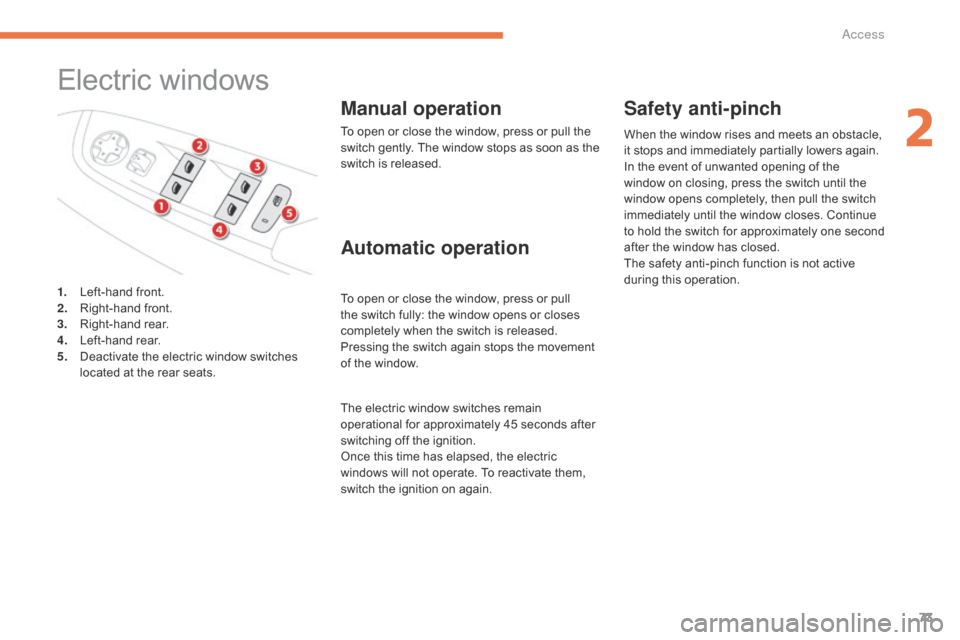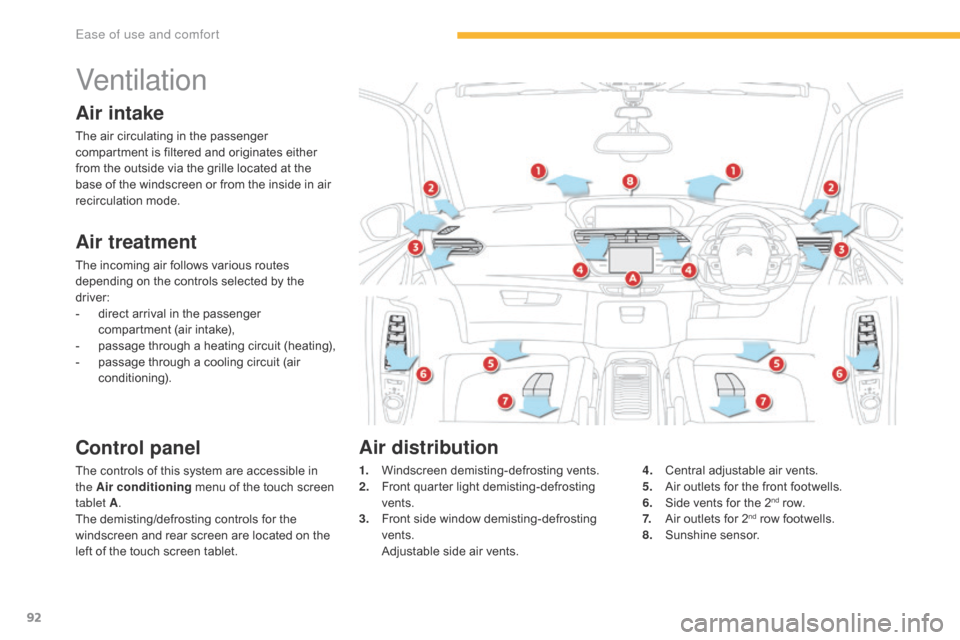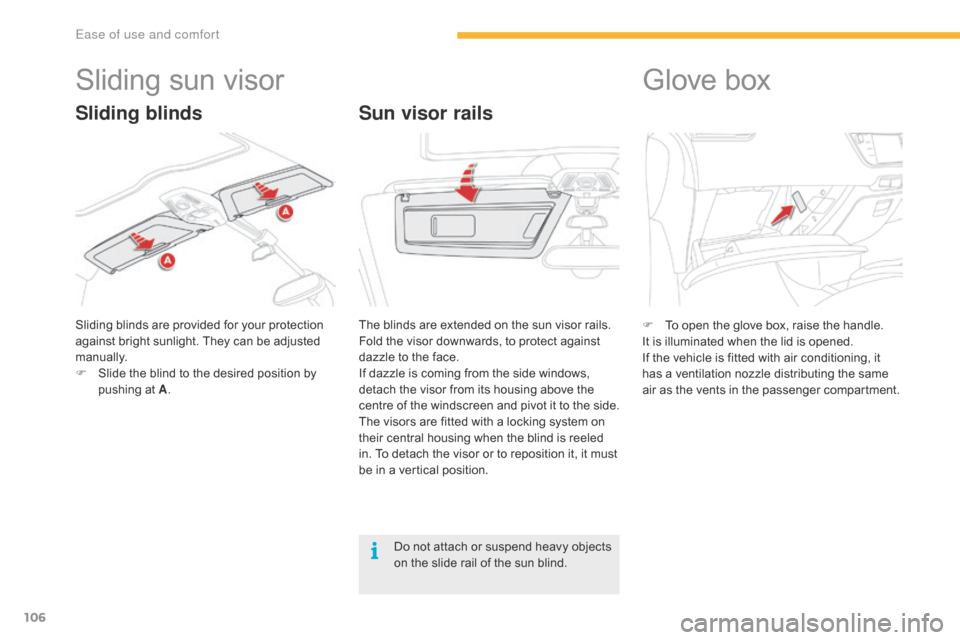2016 Citroen GRAND C4 PICASSO RHD window
[x] Cancel search: windowPage 56 of 523

54
Ensure that nothing could prevent the correct operation of the windows.
Be
aware of children when operating
t
he
w
indows.
Locking the vehicle
F With the electronic key in the recognition z
one A,
press with a finger or thumb
o
n one of the front door handles (at the
m
arkings) to lock the vehicle or press the
l
ocking button on the right of the tailgate.
Maintaining
pressure allows the windows to be
r
aised to the desired position.
It
is not possible to lock the vehicle if one of the
k
eys is left inside the vehicle. The
direction indicators come on for a
f
ew seconds.
Depending
on your version, the door
m
irrors fold and the alarm is activated.
Normal locking
Access
Page 73 of 523

71
OFF
Locking the vehicle with exterior perimeter
monitoring only
Deactivate the interior volumetric monitoring to avoid unwanted triggering of the alarm in
c
ertain cases such as:
-
l
eaving a window partially open,
-
w
ashing your vehicle,
-
c
hanging a wheel,
-
t
owing your vehicle,
-
t
ransport on a ferry.
Deactivating the volumetric
monitoring
F Switch off the ignition and within t
en seconds press this button
u
ntil its indicator lamp is on fixed.
F
G
et
out of the vehicle.
F
I
mmediately lock the vehicle using the
r
emote control or the "Keyless Entry and
S
tarting" system.
Only
the
exterior perimeter protection system is
a
ctive:
the indicator lamp in the button flashes
o
nce
per
second.
To
be
effective, this deactivation must be done
e
very
time the ignition is switched off.
In
the
case
of
automatic
locking
of
the
v
ehicle
(which
occurs
after
a
period
o
f
30
seconds
if
a
door
or
the
boot
is
n
ot
opened),
the
monitoring
system
is
r
eactivated
a
utomatically.
Deactivation
F Press one of the unlocking buttons on the r
emote control:
short press
long
press
or
F
U
nlock the vehicle using the "Keyless Entry
a
nd Starting" system.
The
monitoring system is deactivated: the
i
ndicator lamp in the button is off and the
d
irection indicators flash for about 2 seconds.
Reactivating the interior
volumetric monitoring
F Deactivate the exterior perimeter m
onitoring by unlocking the vehicle using
t
he remote control or the Keyless Entry and
S
tarting system.
The
indicator lamp in the button goes off.
F
R
eactivate the full alarm system by locking
t
he vehicle using the remote control or the
"
Keyless Entry and Starting" system.
The
indicator lamp in the button flashes once
p
er second again.
2
Access
Page 75 of 523

73
Electric windows
Manual operation
To open or close the window, press or pull the switch gently. The window stops as soon as the
s
witch is released.
To
open or close the window, press or pull
t
he switch fully: the window opens or closes
c
ompletely when the switch is released.
P
ressing the switch again stops the movement
o
f the window.
1.
L
eft-hand
front.
2.
R
ight-hand
front.
3.
R
ight-hand
r
ear.
4.
L
eft-hand
r
ear.
5.
D
eactivate
the
electric
window
switches
l
ocated
at
the
rear
seats.
Automatic operation Safety anti-pinch
When the window rises and meets an obstacle, i
t stops and immediately partially lowers again.
In
the event of unwanted opening of the
w
indow on closing, press the switch until the
w
indow opens completely, then pull the switch
i
mmediately until the window closes. Continue
t
o
h
old
t
he
s
witch
f
or
a
pproximately
o
ne
s
econd
a
fter the window has closed.
The
safety anti-pinch function is not active
d
uring this operation.
The
electric
window
switches
remain
o
perational
for
approximately
45
seconds
after
s
witching
off
the
ignition.
Once
this
time
has
elapsed,
the
electric
w
indows
will
not
operate.
To
reactivate
them,
s
witch
the
ignition
on
again.
2
Access
Page 76 of 523

74
Reinitialising the electric
windows
Deactivating the rear
controls for the rear
windows
In the event of contact during operation o
f the windows, you must reverse the
m
ovement of the window. To do this,
p
ress the switch concerned.
When
operating the passenger electric
w
indow switches, the driver must
e
nsure that nothing is preventing
c
orrect closing of the windows.
The
driver must ensure that the
p
assengers use the electric windows
c
o r r e c t l y.
Be
particularly aware of children when
o
perating
t
he
w
indows.
Be
aware of passengers or other
p
ersons present when closing the
w
indows using the electronic key or the
"
Keyless Entry and Starting" system.
Following
reconnection
of
the
battery,
the
s
afety
anti-pinch
function
must
be
reinitialised.
The
safety
anti-pinch
function
is
not
active
d
uring
these
operations.
For
the
safety
of
your
children,
press
s
witch 5 to prevent operation of the
rear
windows
irrespective
of
their
p
ositions.
The
indicator
lamp
in
the
button
comes
on,
a
ccompanied
by
a
message
confirming
a
ctivation.
It
remains
on,
as
long
as
the
child
l
ock
is
off
(deactivated).
Use
of
the
rear
electric
windows
from
the
d
river's
controls
remains
possible. For
each
window:
-
l
ower
the
window
completely,
then
raise
it,
i
t
will
rise
in
steps
of
a
few
centimetres
with
e
ach
action.
Repeat
the
operation
until
the
w
indow
closes
completely,
-
c
ontinue
to
pull
the
switch
for
at
least
o
ne second
after
reaching
this
position,
w
indow
c
losed.
Access
Page 94 of 523

92
Ventilation
Air intake
The air circulating in the passenger compartment is filtered and originates either
f
rom the outside via the grille located at the
b
ase of the windscreen or from the inside in air
re
circulation
m
ode.
Air treatment
The incoming air follows various routes depending on the controls selected by the
d
river:
-
d
irect arrival in the passenger
c
ompartment (air intake),
-
p
assage through a heating circuit (heating),
-
p
assage through a cooling circuit (air
c
onditioning).
Control panel
The controls of this system are accessible in the Air conditioning menu of the touch screen
t
ablet A .
The
demisting/defrosting controls for the
w
indscreen and rear screen are located on the
l
eft of the touch screen tablet. 1. W
indscreen d emisting-defrosting v ents.
2. F ront quarter light demisting-defrosting
ve
nts.
3.
F
ront side window demisting-defrosting
ve
nts.
A
djustable side air vents.4. C
entral adjustable air vents.
5. A ir outlets for the front footwells.
6.
S
ide vents for the 2
nd row.
7. A
ir
outlets
for
2nd row footwells.
8. S
unshine s
ensor.
Air distribution
Ease of use and comfort
Page 98 of 523

96
Air intake / Air recirculation
The intake of exterior air prevents the formation of mist on the windscreen and side windows.
The recirculation of interior air isolates the
passenger
compartment from exterior odours
a
nd smoke.
F
P
ress the button to choose
how
air enters the passenger
c
ompartment.
Air conditioning On / Off
Switching on
Switching off
The air conditioning does not operate when the air flow adjustment is set
t
o off. F
P
ress this button to activate the
air conditioning system.
Avoid
driving
for
too
long
without
r
ecirculation
of
interior
air
(risk
of
m
isting
and
deterioration
of
air
quality).
This
function
allows
hot
or
cold
air
to
be
d
elivered
selectively
and
more
quickly.
The
air conditioning is designed to operate
e
ffectively in all seasons, with the windows closed.
It
enables you to:
-
l
ower the temperature, in summer,
-
i
ncrease the effectiveness of the demisting in
w
inter, above 3°C.
F
P
ress this button again to
d
eactivate the air conditioning
s
ystem.
Air distribution
adjustment
These buttons are used to arrange the distribution of air in the passenger
c
ompartment by combining several air outlets.
Windscreen.
The
air distribution can be adapted by using
s
everal buttons: illumination of the button
c
onfirms the presence of fan boosted air in the
d
irection indicated, the button illumination off
i
ndicates the absence of fan boosted air in the
d
irection
i
ndicated.
For
a uniform distribution of air in the
p
assenger compartment, the three buttons can
b
e
us
ed
s
imultaneously.Footwells.
Central
and side vents.When
the indicator lamp is off, air is taken from
o
utside the vehicle. When the indicator lamp is
o
n, air is recirculated from inside the vehicle,
t
he intake for air outside the vehicle is inhibited.When
the indicator lamp is on, the air
c
onditioning function is activated.
When
the indicator lamp is off, the air
c
onditioning function is deactivated.
Ease of use and comfort
Page 100 of 523

98
The air distribution in the passenger compartment can be adjusted by combining the
u
se of several vents.
Air distribution adjustment
Windscreen.
Footwells.
Centre
and side vents.
The
air
distribution can be varied by using
m
ore
than one button: illumination of the
b
utton
indicates that air is distributed in that
d
irection;
no illumination indicates that air is not
d
istributed in that direction.
In
AUTO
mode, all three buttons are off.Switching off Switching on
Air conditioning On/Off
The air conditioning is designed to operate e
fficiently in all seasons, with the windows
c
losed.
It
allows you:
-
i
n summer, to lower the temperature,
-
i
n winter, above 3 °C, to improve demisting.
Avoid
prolonged operation of the air
r
ecirculation function (risk of misting
a
nd of deterioration of the air quality).
When
the indicator lamp is off, the intake of
e
xterior air is active.
When
the indicator lamp is on, air recirculation
i
s activated, the intake of exterior air is
in
hibited.F
P
ress this button to choose
the
mode for air entry to the
p
assenger
c
ompartment.
The
intake of exterior air avoids misting of the w
indscreen and side windows.
Air
recirculation prevents exterior odours
a
nd smoke from entering the passenger
c
ompartment.
This
function also allows faster heating
o
r cooling of the air in the passenger
c
ompartment.
Air intake/Air recirculation
F Press this button again to switch o
ff the air conditioning.
When
the
indicator lamp is off, the air
c
onditioning system is off.
F
P
ress this button to switch on the
air
c
onditioning.
When
the
indicator lamp is on, the air
c
onditioning system is on.
The
air
conditioning cannot operate when the
a
ir
flow
is
set to off.
Ease of use and comfort
Page 108 of 523

106
Sliding sun visor
Sliding blinds are provided for your protection against bright sunlight. They can be adjusted
m
anually.
F
S
lide the blind to the desired position by
p
ushing at A.
Sun visor rails
Glove box
F To open the glove box, raise the handle.
It is illuminated when the lid is opened.
If
the vehicle is fitted with air conditioning, it
h
as a ventilation nozzle distributing the same
a
ir as the vents in the passenger compartment.
The
blinds
are
extended
on
the
sun
visor
rails.
Fold
the
visor
downwards,
to
protect
against
d
azzle
to
the
face.
If
dazzle
is
coming
from
the
side
windows,
d
etach
the
visor
from
its
housing
above
the
c
entre
of
the
windscreen
and
pivot
it
to
the side.
The
visors
are
fitted
with
a
locking
system
on
t
heir
central
housing
when
the
blind
is
reeled
i
n.
To
detach
the
visor
or
to
reposition
it,
it
must
b
e
in
a
vertical
position.
Sliding blinds
Do not attach or suspend heavy objects o n the slide rail of the sun blind.
Ease of use and comfort